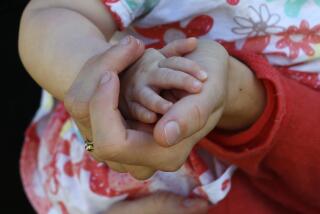90s FAMILY : Looking for the Child Care Model
- Share via
In search of a model to address the “quiet crisis” afflicting this country’s youngest children, Columbia University family policy experts Sheila B. Kamerman and Alfred J. Kahn have turned their sights toward Europe, where paid and job-protected maternity/paternity leave are universal, and where child care is not considered the purview solely of “at risk” families.
In their report, “A Welcome for Every Child: Care, Education and Family Support for Infants and Toddlers in Europe,” the researchers note that in many European countries, child care and family support services are seen as vital to the cognitive and social development of children.
Child care services in these countries are expensive, but heavily subsidized, Kamerman and Kahn report; parent fees for child care constitute less than 10% of the average income of families who use them.
‘Work Won’t Love You Back’
There’s a new manual for dual-career couples with the chillingly apt title of “Work Won’t Love You Back” (W.H. Freeman, 1994). The book, by psychologists Stevan E. and Ivonne H. Hobfoll--a husband/wife team with three children--urges parents to make family-centered accommodations, because “no one on their death bed has ever wished they had spent more time at work.”
Hints at the Causes of Child Behavior
Write what you know, the old axiom goes, and so Cathy Rindner Tempelsman has penned “Child-Wise” (Morrow, 1994). The book, a “compassionate” guide to parent-child relationships, draws on Tempelsman’s own experiences as the working mother of three children to help parents as they react to everyday problems with their children. While no one can explain why children do what they do, this author offers earthy and empathetic insights into the mystery of child behavior.
Unmarried-Couple Category Mushrooms
A Census Bureau study, “Marital Status and Living Arrangements: March 1993,” has found that there were 3.5 million unmarried-couple households in 1993, up from just 523,000 in 1970.
It also found that the median age for first marriage was 26.5 in 1993 for men and 24.5 for women, up from 23.2 and 20.8 respectively in 1970. The number of women living alone rose 94% from 7.3 million to 14.2 million between 1970 and 1993. In the same period men living alone increased 167% from 3.5 million to 9.4 million.
More to Read
Sign up for Essential California
The most important California stories and recommendations in your inbox every morning.
You may occasionally receive promotional content from the Los Angeles Times.













